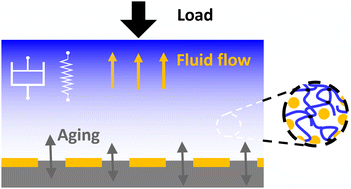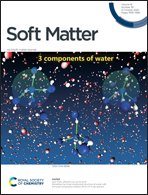Adhesion of fluid infused silicone elastomer to glass†
Abstract
Elastomers swollen with non-polar fluids show potential as anti-adhesive materials. We study the effect of oil fraction and contact time on the adhesion between swollen spherical probes of PDMS (polydimethylsiloxane) and flat glass surfaces. The PDMS probes are swollen with pre-determined amount of 10 cSt silicone oil to span the range where the PDMS is fluid free (via solvent extraction) up to the limit where it is oil saturated. Probe tack measurements show that adhesion decreases rapidly with an increase in oil fraction. The decrease in adhesion is attributed to excess oil present at the PDMS–air interface. Contact angle measurements and optical microscopy images support this observation. Adhesion also increases with contact time for a given oil fraction. The increase in adhesion with contact time can be interpreted through different competing mechanisms that depend on the oil fraction where the dominant mechanism changes from extracted to fully swollen PDMS. For partially swollen PDMS, we observe that adhesion initially increases because of viscoelastic relaxation and at long times increases because of contact aging. In contrast, adhesion between fully swollen PDMS and glass barely increases over time and is mainly due to capillary forces. While the relaxation of PDMS in contact is well-described by a visco-poroelastic model, we do not see evidence that poroelastic relaxation of the PDMS contributes to an increase of adhesion with glass whether it is partially or fully swollen.



 Please wait while we load your content...
Please wait while we load your content...